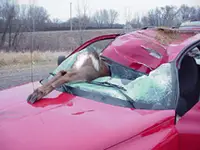As You Steer, Fear the Deer: Tomorrow marks start of two-week peak collision season
 |
ERIE, Pa., Oct. 31, 2007 -- Each year, deer-vehicle crashes cause deaths, injuries and damages, and early November is the most dangerous time of all.
Based upon claims information collected and analyzed by Erie Insurance since 1999, about one in every 100 drivers is likely to have a collision with a deer -- and the first two weeks in November have more claims than any other two-week period during the year. In fact, in 2006 seven of the top 10 deer claims took place between November 3 and 14.
For the past seven years Erie Insurance has launched an aggressive awareness and education campaign among our policyholders and the general public, offering a variety of recommendation on how to avoid collisions with deer. Based on an overall downward trend in claims, this campaign is working.
By being aware of the risks and following precautionary measures, drivers can reduce their likelihood of colliding with a deer.
Know the facts:
-- Deer aren't just found on rural roads near wooded areas; many deer
crashes occur on busy highways near cities.
-- Highest-risk periods are from sunset to midnight and the hours shortly
before and after sunrise.
-- Deer are unpredictable and often dart into traffic.
Be cautious:
-- Stay awake, alert and sober, and always wear your seatbelt.
-- Drive at a safe, sensible speed for conditions.
-- Increase the distance between yourself and the vehicle in front of you,
especially in wooded areas.
-- Be extra alert in areas where deer commonly cross roads and where roads
divide fields from forests.
-- When driving at night, use high-beam headlights -- which illuminate
deer eyes -- when there is no opposing traffic.
When deer are near, be careful.
-- Slow down and blow your horn to urge the deer to leave the road --
never rely on devices such as deer whistles, deer fences, and
reflectors to deter deer.
-- Keep an eye out for other deer, as they frequently travel single-file
in groups.
-- If the deer stays on the road, stop, put on your hazard lights and wait
for the deer to leave the roadway.
-- Never try to drive around a deer while it's on the road or swerve your
vehicle to avoid striking a deer.
"Always keep your eyes on the road, doing a visual sweep for deer," advises Darrin Birtciel, Erie Insurance rate analyst. "If you're going 60 mph, you can cover a lot of ground in just a few seconds -- 30 yards per second or the length of a football field in the time it takes to change a CD or reach for your travel mug."
If you do collide with a deer, keep your distance to avoid injuries. If the deer is blocking the roadway, contact the Game Commission or a local law enforcement agency.
For more information about deer collisions, visit http://www.erieinsurance.com/.
According to A.M. Best Company, Erie Insurance Group, based in Erie, Pennsylvania, is the 15th largest automobile insurer in the United States based on direct premiums written and the 22nd largest property/casualty insurer in the United States based on total lines net premium written. The Group, rated A+ (Superior) by A.M. Best Company, has over 3.8 million policies in force and operates in 11 states and the District of Columbia. Erie Insurance Group ranked 463 on the FORTUNE 500 and Erie Indemnity Company is included in Forbes Magazine's PLATINUM 400 list of the best- managed companies in America. To learn more, visit http://www.erieinsurance.com/.
NOTE TO EDITORS: Erie Insurance can provide county-specific information (including maps) upon request.


